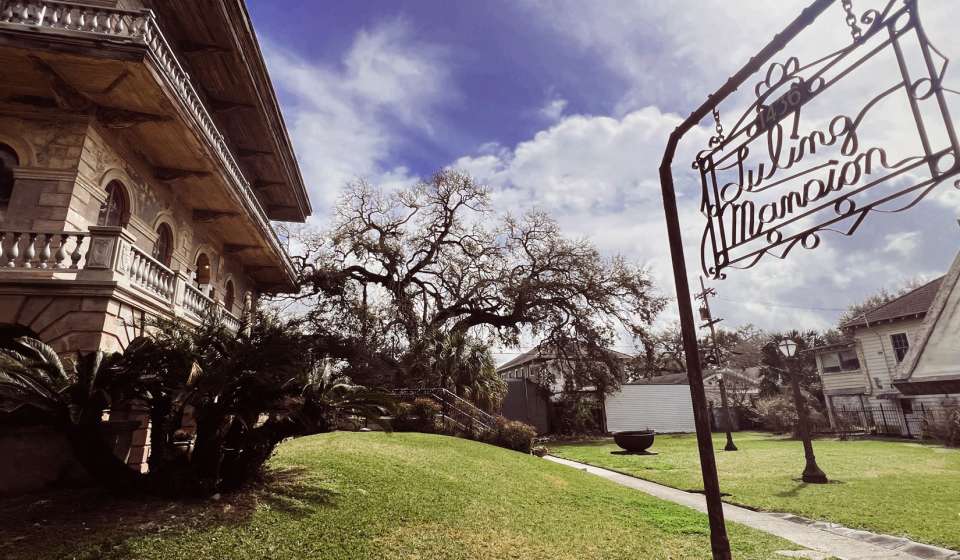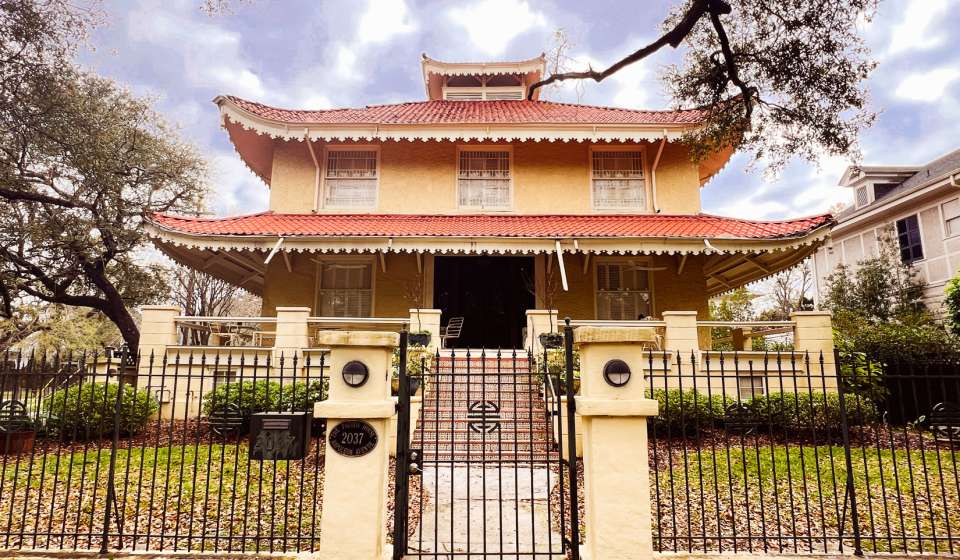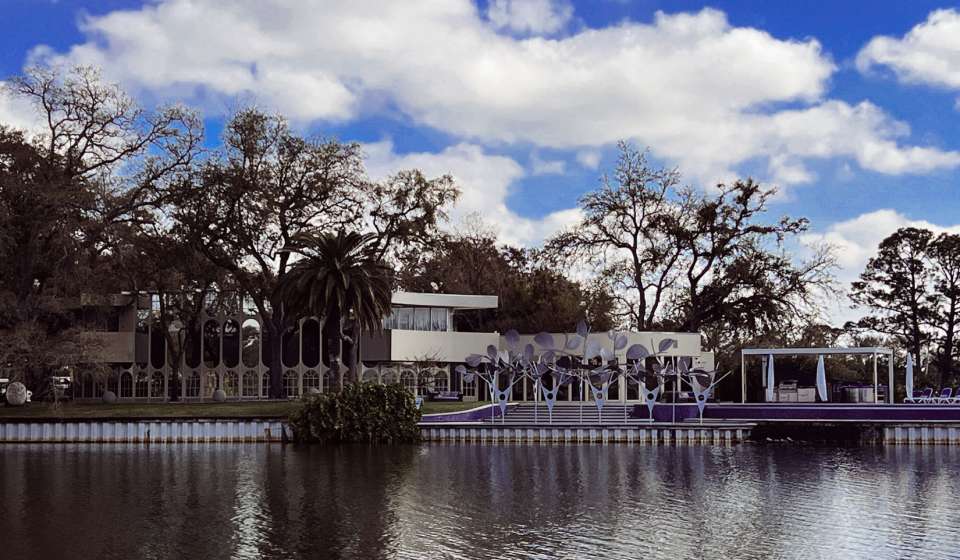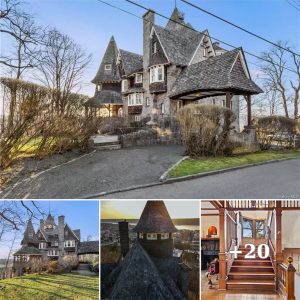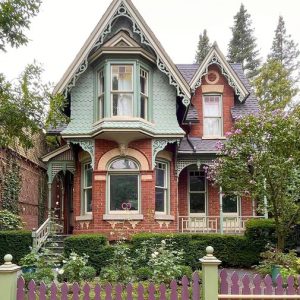
Mads Reineke, New Orleans & Co.
Doullut Steamboat House
Doullut Steamboat House(s)
400 EGANIA ST. AND 5301 DOUGLASS ST.
These architectural gems sit a-ways outside of the palatial estates of the Garden District in New Orleans’ Lower Ninth Ward, looking as if they’ve docked straight from the nearby Mississippi River. Both Steamboat Houses are named for their designer and architect Captain Milton Doullut, who, unsurprisingly, worked all his life as a riverboat captain, engineer, and shipbuilder. Captain Doullut’s wife Mary also had boating in her blood and became the first woman to earn a pilot’s license for inland waterways in south Louisiana.
Doullut put his shipbuilding expertise to the test in 1905 when he decided to construct a new home for his family – a project he took on in his spare time with help from his son and hired hand. Rather than the obvious inspiration of the classic riverboats he piloted every day, Dollout’s original inspiration came from a Japanese pagoda (most notable in the houses’ green-shingled rooves) he saw on display at the World’s Fair in St. Louis the year prior. However, the Doullut family’s maritime roots shone through in the finalized design, which sports a cupola resembling a wheelhouse, metal chimneys like smokestacks, and wrap-around galleries like ship decks. The likeness was so convincing that, according to Mary Doullut, a steamboat ran aground in front of the house one night, mistaking it for a docked vessel in the dark. The family fell so in love with their home, that they built the second Steamboat House in 1913 catty-corner to the original, both adorned with strands of large beads on the upper galleries and intricate pressed-tin filigree on the roof edges.
Although Milton Doullut died in 1928, Mary continued to live in the original Steamboat house until her death in 1959 at age 94.
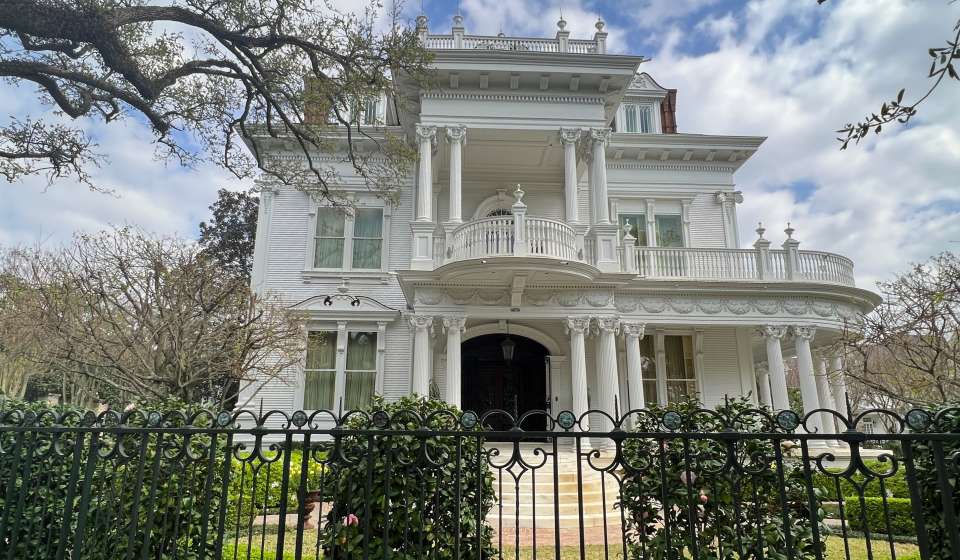
Mads Reineke, New Orleans & Co.
Wedding Cake House
Wedding Cake House
5809 ST. CHARLES AVE.
This decadent manor (originally referred to as “the Jewel of America’s Grand Avenues”) stands out even among the gorgeous estates on one of NOLA’s most famous promenades – St. Charles Avenue. As the nickname suggests, this Victorian Gregorian mansion is a feast to the eyes, sporting three tiers of elegant embellishments and painted all white, resembling an enormous wedding cake with intricate piping. The main décor is featured on the second-story gallery – supported by ionic columns draped in garlands and a base entablature adorned in garland friezes. This “tier” is further embellished by balustrades topped with finials modeled after classical urns and windows framed with scroll brackets, moldings, and gooseneck gables. All these intricacies are topped with curled cornices and elaborate dormer windows. The curved gallery on the side of the house gives the illusion of asymmetry, but it’s matched on the opposite side by an identically adorned porte-cochère (a covered entrance for vehicles).
Fittingly, original owner Nicholas Burke funded the Wedding Cake House’s construction in 1896 after making his fortune in the retail grocery business. Burke also went on to co-found Hibernia National Bank, serving on the board of directors for both the bank and the Hibernia Insurance Company. At the time, Burke paid only $13,000 for the home, which is now worth closer to $4.23 million. The house had to be mostly rebuilt after a fire in 1907, and it remained as property of the Burke family until it was sold to Rosalie and Nicholas Chisesi in 1993. Currently, attorneys Calvin and Frances Fayard are the lucky residents of St. Charles Avenue’s sweetest mansion.
Luling Mansion – 1436 Leda Ct.
Luling Mansion
1436 LEDA CT.
While the sheer magnitude of this palatial estate is enough to turn heads, much of the draw of this Esplanade Ridge marvel comes from the tragic legends surrounding both its original owners (and, to a lesser extent, its architect) and the house’s slow decline into a hidden gem among its residential neighbors. The Italianate-style mansion was once even larger than it is now, sporting two additional buildings connected to the main three-story house by a colonnade (a covered walkway lined with columns); one building supposedly housed the kitchen while the other was rumored to have a bowling alley. The original grounds stretched from Esplanade Avenue to the Fair Grounds Racetrack, covering 30 acres with gardens, statues, a lake, a small island, and a stable with enough space for 100 horses. Architectural sketches also show that the building was designed using forced perspective – making the lower floor gradually smaller than the upper – in order to give the home an even more grandiose appearance. With its impressive granite exterior staircase, marble and mahogany-accented 18-room layout, and rooftop belvedere/observation deck, Luling Mansion is like the estate from the board game “Clue” come to life.
Detail of the Luling Mansion – 1436 Leda Ct.
Pagoda House – 2037 Napoleon Ave.
Pagoda House
2037 NAPOLEON AVE.
As with the Luling Mansion, the Pagoda House has its origins steeped in a bit of mystery, though its story is far less tragic and involves one of the city’s adopted writers – Lafcadio Hearn.
Detail of the cornstalk fence at 915 Royal Street
Cornstalk Fences
Though corn isn’t a common crop in Louisiana, the city has three intact and well-maintained versions of this rare design in different locations around the city. The pattern features repeating cornstalks wreathed in morning glories that wrap around tree-trunk fenceposts, each with a pumpkin at its base. They were historically painted in the vivid colors of the Picturesque style (the architectural equivalent to American romanticism) which focused on emotion and spontaneity over reason and control. Credit for originating this pastoral pastiche belongs to Dr. Joseph Secondo Biamenti who first commissioned the design, as well as the ornamental ironworks manufacturer Wood, Miltenberger, & Co.
Robert Wood opened his original foundry in Philadelphia in 1839, and, by 1857, he combined his forces with Elliston Perot to form Wood & Perot Ornamental Iron Works. As cursory walk through the French Quarter and Lower Garden District shows, ornamental ironwork has been an architectural signature of New Orleans since its founding, so Wood and Perot established another branch on Camp Street to keep up with demand locally – the aforementioned Wood, Miltenberger, & Co. The company continued producing many famous ornamental cast-iron elements for fences, balconies, and even graves in New Orleans until its bankruptcy in 1878.
The Cornstalk Hotel – 915 Royal St.
The Cornstalk Hotel
915 ROYAL ST.
Dr. Biamenti commissioned the fence for his wife who was homesick for the corn fields of her native Iowa for their French Quarter home at 915 Royal St. The house itself features a castle-tower-style turret and was originally built in 1816 for Francois Xavier Martin, then-chief justice of the Louisiana Supreme Court. Dr. Biamenti purchased the house in 1834 and added the fence in 1856 from Wood & Perot in Philadelphia. This newly designed pattern was featured in the company’s catalog two years later. Currently, the house is the Cornstalk Hotel, which has hosted a myriad of guests over the years, including Harriet Beecher Stowe and Elvis Presley.
Colonel Short’s Villa, also called the Cornstalk Fence Mansion
Cornstalk Fence Mansion
1448 FOURTH ST.
It’s from this catalog (and possibly for another homesick Iowan wife) that the city’s most well-known cornstalk fence was commissioned in 1858 – that of Col. Robert Short for his home at 1448 Fourth St. (you can find more about the villa on our page about Historic Garden District Homes). Most recently, Scott Roger – renowned in the music world for managing and producing for artists like Paul McCartney and Andrea Bocelli – owned what most locals call the “Cornstalk Fence Mansion,” but it has since been sold to a different local family.
Dufour-Plassan House with Cornstalk Fence – 1206 N. White Street
Dufour-Plassan House
1206 N. WHITE ST.
Lastly, the Dufour-Plassan House at 1206 N. White St. in Mid-City boasts the most colorful cornstalk fence. Unlike the other two, only part of the fence is of Wood, Miltenberger, and Co. make; the entire side portion of the original fence had been dismantled and replaced with a hedge. In the 1980s, one of the home’s co-owners Kel Boudreaux undertook the tremendous effort to replace the missing bit of fence – a feat that makes this the first cast iron cornstalk fence to have been built in over a century. Even once Boudreaux located a foundry to take on the job (Nadler Foundry outside of Baton Rouge), he still needed to unearth one of the posts to cast a new mold. This brought up another issue: the posts themselves are nine feet tall, with three feet buried underground and encased in clay to keep them upright in the soft, waterlogged New Orleans soil. Once installed, the home’s other owner Jay Calamia repainted the fence over several months. Boudreaux even went on to develop a line of cast iron ornamental fences based on traditional local designs.
Mid-Mod Marvels
“Modern” isn’t the first word to come to mind when thinking about New Orleans, especially regarding architecture. But, the city is full of structures that typify this unique and nostalgic style – two of which, the Caesars Superdome and the Plaza Tower, are staples of NOLA’s signature downtown skyline. What’s more, New Orleans also produced two well-known mid-century modern architects: Albert Ledner and Leonard Spangenberg, both of whom trained under the illustrious Frank Lloyd-Wright and designed commercial and residential buildings both locally and internationally.
If you dream of the retro, quirky designs of ages past, then you won’t want to miss the buildings listed below. There are many more mid-mod delights scattered throughout the neighborhoods of Lakeview and Gentilly if you’re simply looking for a relaxing drive and a bit of that Lake Pontchartrain breeze.
Albert Ledner
Albert Ledner may be the city’s most well-known modern architect, with an upbeat personality and unceasing sense of creativity driving a career featuring designs that span both cities and continents. Part of what makes Ledner’s work so unique was his use of everyday materials to create one-of-a-kind design elements, combining modernist tropes with his own style. Many is his family credit Ledner’s moxie and out-of-the-box thinking to his grandmother Beulah Ledner, inventor of the Doberge cake (one of the city’s most famous confections) and noted that, since an early age, he had a proclivity towards “taking things apart and figuring them out.”
He enrolled at Tulane University to study architecture and enlisted in the Army Air Corps after his first year, when he was stationed in Tucson, AZ. This move was fortuitous, however, as his flight training took him over Frank Lloyd Wright’s Taliesin West in Scottsdale, which he later drove out to explore in his free time. With renewed inspiration, Ledner returned to Tulane after his tour of duty and graduated with an architecture degree in 1948, studying briefly with Wright before founding his own firm the following year. Aside from the many residential buildings in his native New Orleans, Ledner’s largest projects are a series of union offices and union halls for the National Maritime Union located in the Chelsea district of NYC.
Albert Ledner passed in 2017 at the age of 93, leaving behind a legacy that, while not as prolific as other architects, is one with a character, innovativeness, and charm that have carried through the decades. That same year, Ledner’s daughter Catherine and director/writer Roy R. Beeson created Designing Life: The Modernist Architecture of Albert C. Ledner, a documentary about the life and work of Catherine’s late father.
Ashtray House – 28 Park Island Drive.
Ashtray House
28 PARK ISLAND DR.
This tucked-away street rests on the opposite bank of Bayou St. John from City Park and hosts two iconic Ledner designs. He designed the Ashtray House for Adrian and Patricia Sunkel in 1962, and the couple’s smoking habits inspired the home’s namesake feature – an exterior (and interior) trim of amber ashtrays that act as both accents and provide ambient lighting. Ledner noted that when he met with the Sunkels to brainstorm about the home’s design, they were both using this exact type of tray to dab their cigarettes.
Upon entering through the driveway, the single-story wing of the home begins with an office space and a rosewood paneled hallway containing the doors to three first-floor bedrooms and ending in a sitting room with access to the backyard and pool. The kitchen and dining space are located near the back of the house from this sitting room. Ledner’s personal care for each of his designs shines through in the smaller details. On the opposite end of the house from the garage is the juncture of the single-story wing and the two-story glass wing, which is outfitted with lighting fixtures custom designed by Ledner. Along with taking a trip to the Milk of Magnesia factory in Mississippi, he also fashioned multiple polymer light fixtures to give a special ambiance to this windowed-walled room. Here, a fireplace occupies the same wall as a cantilevered staircase, which leads to the primary suite, which is the only cluster of rooms on the house’s second floor. Ledner also designed the plot’s natural landscaping, positioning the multiple trees on the property so as not to take away from the exterior astray detailing. Dan Robin, Jr., one of the house’s former owners, said that this attention to detail made sleeping in the main bedroom feel like sleeping in a fancy treehouse. Robin also noted that throughout his years owning the home, Ledner was always happy to talk about the home and answer any questions Robin may have had.
(Find some great pics here).
Galatoire House – 11 Park Island Dr.
Galatoire House
11 PARK ISLAND DR.
Catty-corner to the Ashtray House sits another prime example of Ledner’s work: the Galatoire House. Though, unlike its sibling, this mid-mod marvel is on full display from the opposite bank of Bayou St. John – most notably by a later installation of the Floating Leaves, an element of the Wonderwall at the 1984 World’s Fair designed by Kent Bloomer. Ledner completed the house in 1966 for Leonie Galatoire, a descendant of the owners of the eponymous Galatoire’s Restaurant. She had a stipulation about the design, however; it had to include a collection of stained-glass windows that Galatoire had salvaged from the Good Shepherd Convent, a school for delinquent girls that had been constructed exactly 100 years prior to the Galatoire House.
Looking at any of Ledner’s designs, it’s clear that this sort of challenge was right up his alley, and he executed it as only he could. He repurposed the windows and installed many upside-down alongside other arched windows on the front of the home and crafted stained-glass ceiling panels placed beneath curved balconies.
Ledner Family Home – 5328 Bellaire Drive
Ledner Family Home
5328 BELLAIRE DR.
With all the one-of-a-kind designs Ledner crafted over the years, it’s only natural that his family home would be another prime example of his work – particularly, his fascination with light, structural forms, and energy. The central shape of the house is crystalline, a structure of two six-pointed stars connected by a rhomboid-shaped foyer capped by a 12-gabled, pleated roof held aloft by multi-faceted walls and harp-shaped buttresses. A combination of diamond-shaped clerestory windows, skylights, and an oculus fill the space with indirect natural light during the day, an effect that is only enhanced by mirror panels below each skylight, an indoor exotic garden filled with glass sculptures and a prismatic wall mosaic, and innovative light fixtures crafted by Ledner himself. Rather than the classic rectangular-shaped architecture – see traditional New Orleans shotgun houses – Ledner’s design lends itself to an organic, radiant feeling, allowing for a sense of natural ease and interconnectivity between rooms of the home. (For a look at the interior, check out this issue of the Preservation Resource Center’s magazine.)
Unity of New Orleans Spiritual Center – 3722 St. Charles Ave.
Unity of New Orleans Spiritual Center
3722 ST. CHARLES AVE.
This mid-mod landmark stands out among the classical designs of its neighboring Uptown homes but is no less truly New Orleanian than its designer Leonard Spangenberg. Spangenberg was born and raised in NOLA and, like Ledner, studied under Frank Lloyd Wright – particularly at Wright’s Taliesin, his home, studio, and organic architecture laboratory, in Spring Green, WI. In 1950, Spangenberg acted as Wright’s supervising apprentice at the Fuller residence in Pass Christian, MS, which was the closest Wright-designed residence to New Orleans until its destruction by Hurricane Camille in 1969. Spangenberg’s legacy is visible throughout the New Orleans metro area in both residential and commercial architecture, and he is lauded as one of the key liaisons for bringing Wright-inspired modern architecture to NOLA and combining it with local flair.
Wright also happened to construct a Unity Temple in Illinois (now a UNESCO World Heritage Site), but, while Spangenberg’s design certainly takes influence from his mentor’s techniques and design ideals, the two buildings couldn’t look more different. Spangenberg’s temple is entirely void of horizontal right angles, constructed of two interlocking disc-shaped wings with dome roofs and skylights. The building’s low-lying profile is ringed by deep overhangs and curved ribbon windows, and the motif of roundness is echoed in even smaller details including lighting fixtures, site paving, interior built-in furniture, flower beds, and a fascia (the vertical band under the edge of a roof) decorated with a circular motif. “I thought the interior space should be plastic and flowing, light and cheerful in both color and texture,” Spangenberg relayed to the Times-Picayune’s Dixie magazine in 1961.
Spangenberg’s firm went on to design two other midcentury-modern commercial towers in the Greater New Orleans Area, both of which are on the Louisiana National Register of Historic Places – the Plaza Tower in the CBD and the New Orleans Federal Savings & Loan building in Chalmette. Plaza Tower (1001 Howard Ave.) was completed in 1969 and is lauded as a feat of engineering, employing a friction-based structural foundation that allowed for much taller buildings to stand firm on NOLA’s soft soil. Architects Gordon I. Kuhne and Raymond C. Bergeron of Leonard Reese Spangenberg & Associates Architects were the minds behind what, for four years, was New Orleans’ tallest building, one that mixes elements from many of the major architecture movements of the twentieth century, including futurism, expressionism, modernism, constructivism, and, naturally, the work of Frank Lloyd Wright. The New Orleans Federal Savings & Loan Building (4948 Chef Menteur Hwy.) was designed by Spangenberg himself and built in 1965 and is described in its National Register nomination as having “re-strained geometric ornament; pier-like vertical banding that distinguishes the building’s upper floors from its planar base,” and “cantilevered projections with copper fascia that provide a strong horizontal element and a visual cap,” both of which showcase Wright’s influence in his work.

